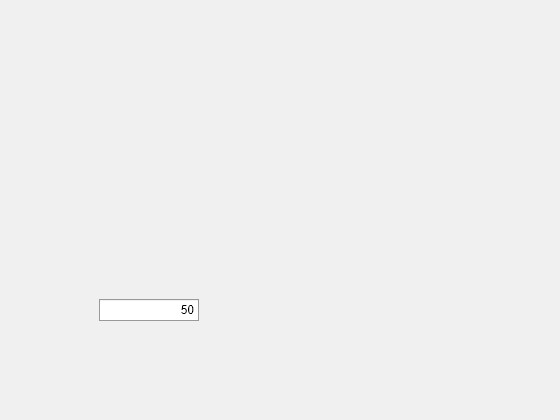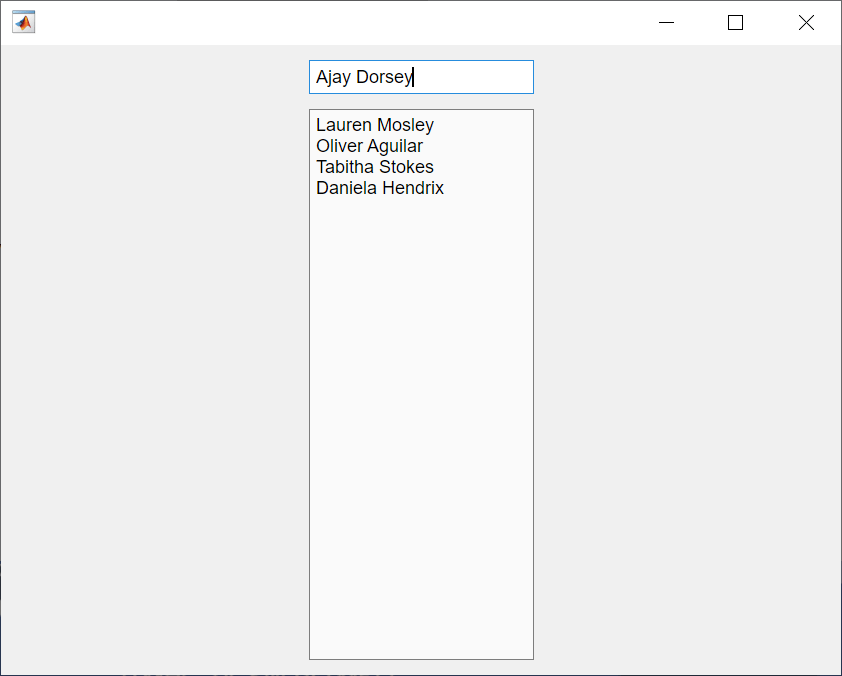EditField
编辑字段 UI 组件

说明
编辑字段 UI 组件允许 App 用户在 App 中输入文本。在创建编辑字段后,使用 EditField 对象修改其外观和行为。
创建对象
使用 uieditfield 函数在 App 中创建一个编辑字段。
属性
文本
编辑字段中的文本,指定为字符向量或字符串标量。MATLAB® 将文本显示为单行。如果您要允许多行文本,请使用文本区域组件而不是编辑字段。
示例: 'Hello world'
编辑字段文本的最小和最大字符数,指定为二元素数值数组。第一个值必须小于或等于第二个值,并且两个值都必须为非负值。要指定无上限,请将第二个数组元素设置为 Inf。
如果您更改 CharacterLimits,使得 Value 中的字符数超出新限制,MATLAB 会将 Value 重置为 ''。例如,假设 CharacterLimits 为 [0 5],Value 为 'Hello'。如果将 CharacterLimits 更改为 [6 Inf],则 MATLAB 将 Value 设置为 ''。
如果您指定大于 0 的下限,则在以下设置中,Value 仍然可能是 '':
编辑字段是使用默认值创建的,App 用户尚未输入
CharacterLimits范围内的有效值。如上面所述,在您更改
CharacterLimits后导致Value属性发生重置。
示例: [0 3]
示例: [5 5]
示例: [2 Inf]
有效文本内容,指定为下列值之一:
'text'- 任何文本都有效。'letters'- 文本必须全部由字母组成。'digits'- 文本必须全部由数字组成。'alphanumerics'- 文本必须全部由字母和数字组成。
编辑字段中的占位符文本,指定为字符向量或字符串标量。占位符提供简短的提示来说明预期的输入。仅当 Value 属性为 '' 时,文本才会显示。
示例: 'Enter text'
编辑字段中文本的对齐方式,指定为 'left'、'right' 或 'center'。对齐方式影响 App 用户编辑编辑字段时的显示方式,还影响 MATLAB 在 App 中显示文本的方式。
字体和颜色
字体名称,指定为系统支持的字体名称。默认字体取决于具体操作系统和区域设置。
如果指定的字体不可用,MATLAB 将使用运行 App 的系统上的可用字体中的最佳匹配项。
示例: 'Arial'
字体大小,指定为正数。测量单位为像素。默认字体大小取决于具体操作系统和区域设置。
示例: 14
字体粗细,指定为下列值之一:
'normal'- 特定字体定义的默认粗细'bold'- 字符轮廓比'normal'粗
并非所有字体都有加粗字体。对于非加粗字体,指定 'bold' 会得到普通字体。
字体角度,指定为 'normal' 或 'italic'。并非所有字体都有倾斜字体角度。对于无斜体字体,指定 'italic' 后会使用常规字体角度。
字体颜色,指定为 RGB 三元组、十六进制颜色代码或下表中列出的选项之一。
RGB 三元组和十六进制颜色代码对于指定自定义颜色非常有用。
RGB 三元组是包含三个元素的行向量,其元素分别指定颜色中红、绿、蓝分量的强度。强度值必须位于
[0,1]范围内,例如[0.4 0.6 0.7]。十六进制颜色代码是字符向量或字符串标量,以井号 (
#) 开头,后跟三个或六个十六进制数字,范围可以是0到F。这些值不区分大小写。因此,颜色代码"#FF8800"与"#ff8800"、"#F80"与"#f80"是等效的。
此外,还可以按名称指定一些常见的颜色。下表列出了命名颜色选项、等效 RGB 三元组和十六进制颜色代码。
| 颜色名称 | 短名称 | RGB 三元组 | 十六进制颜色代码 | 外观 |
|---|---|---|---|---|
"red" | "r" | [1 0 0] | "#FF0000" |
|
"green" | "g" | [0 1 0] | "#00FF00" |
|
"blue" | "b" | [0 0 1] | "#0000FF" |
|
"cyan" | "c" | [0 1 1] | "#00FFFF" |
|
"magenta" | "m" | [1 0 1] | "#FF00FF" |
|
"yellow" | "y" | [1 1 0] | "#FFFF00" |
|
"black" | "k" | [0 0 0] | "#000000" |
|
"white" | "w" | [1 1 1] | "#FFFFFF" |
|
下表列出了浅色和深色主题中绘图的默认调色板。
| 调色板 | 调色板颜色 |
|---|---|
在 R2025a 之前的版本中: 大多数绘图默认使用这些颜色。 |
|
|
|
您可以使用 orderedcolors 和 rgb2hex 函数获取这些调色板的 RGB 三元组和十六进制颜色代码。例如,获取 "gem" 调色板的 RGB 三元组并将其转换为十六进制颜色代码。
RGB = orderedcolors("gem");
H = rgb2hex(RGB);在 R2023b 之前的版本中: 使用 RGB = get(groot,"FactoryAxesColorOrder") 获取 RGB 三元组。
在 R2024a 之前的版本中: 使用 H = compose("#%02X%02X%02X",round(RGB*255)) 获取十六进制颜色代码。
背景颜色,指定为 RGB 三元组、十六进制颜色代码或下表中列出的颜色选项之一。
RGB 三元组和十六进制颜色代码对于指定自定义颜色非常有用。
RGB 三元组是包含三个元素的行向量,其元素分别指定颜色中红、绿、蓝分量的强度。强度值必须位于
[0,1]范围内,例如[0.4 0.6 0.7]。十六进制颜色代码是字符向量或字符串标量,以井号 (
#) 开头,后跟三个或六个十六进制数字,范围可以是0到F。这些值不区分大小写。因此,颜色代码"#FF8800"与"#ff8800"、"#F80"与"#f80"是等效的。
此外,还可以按名称指定一些常见的颜色。下表列出了命名颜色选项、等效 RGB 三元组和十六进制颜色代码。
| 颜色名称 | 短名称 | RGB 三元组 | 十六进制颜色代码 | 外观 |
|---|---|---|---|---|
"red" | "r" | [1 0 0] | "#FF0000" |
|
"green" | "g" | [0 1 0] | "#00FF00" |
|
"blue" | "b" | [0 0 1] | "#0000FF" |
|
"cyan" | "c" | [0 1 1] | "#00FFFF" |
|
"magenta" | "m" | [1 0 1] | "#FF00FF" |
|
"yellow" | "y" | [1 1 0] | "#FFFF00" |
|
"black" | "k" | [0 0 0] | "#000000" |
|
"white" | "w" | [1 1 1] | "#FFFFFF" |
|
下表列出了浅色和深色主题中绘图的默认调色板。
| 调色板 | 调色板颜色 |
|---|---|
在 R2025a 之前的版本中: 大多数绘图默认使用这些颜色。 |
|
|
|
您可以使用 orderedcolors 和 rgb2hex 函数获取这些调色板的 RGB 三元组和十六进制颜色代码。例如,获取 "gem" 调色板的 RGB 三元组并将其转换为十六进制颜色代码。
RGB = orderedcolors("gem");
H = rgb2hex(RGB);在 R2023b 之前的版本中: 使用 RGB = get(groot,"FactoryAxesColorOrder") 获取 RGB 三元组。
在 R2024a 之前的版本中: 使用 H = compose("#%02X%02X%02X",round(RGB*255)) 获取十六进制颜色代码。
交互性
可见性状态,指定为 'on' 或 'off',或者指定为数值或逻辑值 1 (true) 或 0 (false)。值 'on' 等效于 true,'off' 等效于 false。因此,您可以使用此属性的值作为逻辑值。该值存储为 matlab.lang.OnOffSwitchState 类型的 on/off 逻辑值。
'on'- 显示对象。'off'- 隐藏对象而不删除它。您仍然可以访问不可见 UI 组件的属性。
要使您的 App 更快地启动,请将不需要在启动时出现的所有 UI 组件的 Visible 属性设置为 'off'。
编辑字段是否可编辑,指定为 'on' 或 'off',或者指定为数值或逻辑值 1 (true) 或 0 (false)。值 'on' 等效于 true,'off' 等效于 false。因此,您可以使用此属性的值作为逻辑值。该值存储为 matlab.lang.OnOffSwitchState 类型的 on/off 逻辑值。
此属性可与 Enable 属性值结合使用,以确定组件是否响应以及如何响应 App 用户的输入:
要使编辑字段可编辑并且关联的回调可触发,请将
Enable属性值和Editable属性值都设置为'on'。
要使编辑字段不可编辑,但文本易于阅读,请将
Enable属性值设置为'on',将Editable属性值设置为'off'。
要使编辑字段不可编辑并且使文本灰显,请将这两个属性都设置为
'off'。
编辑字段的工作状态,指定为 'on' 或 'off',或者指定为数值或逻辑值 1 (true) 或 0 (false)。值 'on' 等效于 true,'off' 等效于 false。因此,您可以使用此属性的值作为逻辑值。该值存储为 matlab.lang.OnOffSwitchState 类型的 on/off 逻辑值。
此属性可与 Editable 属性值结合使用,以确定组件是否响应以及如何响应 App 用户的输入:
要使编辑字段可编辑并且关联的回调可触发,请将
Enable属性值和Editable属性值都设置为'on'。
要使编辑字段不可编辑,但文本易于阅读,请将
Enable属性值设置为'on',将Editable属性值设置为'off'。
要使编辑字段不可编辑并且使文本灰显,请将这两个属性都设置为
'off'。
工具提示,指定为字符向量、字符向量元胞数组、字符串数组或一维分类数组。如果使用此属性,则在运行时当用户将指针悬停在组件上时,将显示消息。即使禁用组件,工具提示也会显示。要显示多行文本,请指定字符向量元胞数组或字符串数组。数组中的每个元素变为一行文本。如果将此属性指定为分类数组,MATLAB 将使用数组中的值,而不是完整的类别集。
上下文菜单,指定为使用 uicontextmenu 函数创建的 ContextMenu 对象。使用此属性可在您右键点击组件时显示上下文菜单。
位置
编辑字段相对于父级的位置和大小,指定为向量 [left bottom width height]。此表介绍该向量中的每个元素。
| 元素 | 描述 |
|---|---|
left | 父容器的内部左边缘与编辑字段的外部左边缘之间的距离 |
bottom | 父容器的内部下边缘与编辑字段的外部下边缘之间的距离 |
width | 编辑字段的左右外部边缘之间的距离 |
height | 编辑字段的上下外部边缘之间的距离 |
所有测量值都以像素为单位。
Position 值相对于父容器的可绘制区域。可绘制区域是指容器边框内的区域,不包括装饰元素(如菜单栏或标题)所占的区域。
示例: [150 130 100 22]
编辑字段的内部位置和大小,指定为 [left bottom width height]。位置值相对于父容器。所有测量值都以像素为单位。此属性值等同于 Position 属性值。
此 属性 为只读。
编辑字段的外部位置和大小,以 [left bottom width height] 形式返回。位置值相对于父容器。所有测量值都以像素为单位。此属性值等同于 Position 属性值。
布局选项,指定为 GridLayoutOptions 对象。此属性为网格布局容器的子级组件指定选项。如果组件不是网格布局容器的子级(例如,它是图窗或面板的子级),则此属性为空且不起作用。但是,如果组件是网格布局容器的子级,则可以通过在 GridLayoutOptions 对象上设置 Row 和 Column 属性,将组件放置在网格的所需行和列中。
例如,以下代码将一个编辑字段放置在其父网格的第三行第二列中。
g = uigridlayout([4 3]); ef = uieditfield(g); ef.Layout.Row = 3; ef.Layout.Column = 2;
要使该编辑字段跨多个行或列,请将 Row 或 Column 属性指定为二元素向量。例如,此编辑字段跨列 2 到 3:
ef.Layout.Column = [2 3];
回调
更改值后执行的回调,指定为下列值之一:
函数句柄。
第一个元素是函数句柄的元胞数组。元胞数组中的后续元素是传递到回调函数的参量。
包含有效 MATLAB 表达式的字符向量(不推荐)。MATLAB 在基础工作区计算此表达式。
当用户更改编辑字段中的文本并按 Enter 键或在编辑字段外部点击时,将会执行此回调。如果以编程方式更改编辑字段值,将不会执行此回调。
此回调函数可以访问有关用户与编辑字段的交互的特定信息。MATLAB 将 ValueChangedData 对象中的此信息作为回调函数的第二个参量进行。在 App 设计工具中,该参量名为 event。您可以使用圆点表示法查询对象属性。例如,event.PreviousValue 返回编辑字段的上一个值。ValueChangedData 对象不可用于指定为字符向量的回调函数。
下表列出了 ValueChangedData 对象的属性。
| 属性 | 值 |
|---|---|
Value | 编辑字段在 App 用户最近一次与它交互之后的值 |
PreviousValue | 编辑字段在 App 用户最近一次与它交互之前的值 |
Source | 执行回调的组件 |
EventName | 'ValueChanged' |
有关编写回调的详细信息,请参阅App 设计工具中的回调。
更改值后执行的回调,指定为下列值之一:
函数句柄。
第一个元素是函数句柄的元胞数组。元胞数组中的后续元素是传递到回调函数的参量。
包含有效 MATLAB 表达式的字符向量(不推荐)。MATLAB 在基础工作区计算此表达式。
此回调按照如下方式执行:
当用户在编辑字段中键入时,回调将重复执行。
当用户按 Enter 键时,回调执行。
如果以编程方式更改编辑字段值,则不会执行回调。
此回调函数可以访问有关用户与编辑字段的交互的特定信息。MATLAB 将 ValueChangingData 对象中的此信息作为回调函数的第二个参量进行。在 App 设计工具中,该参量名为 event。您可以使用圆点表示法查询对象属性。例如,event.Value 是编辑字段中触发了回调执行的值。ValueChangingData 对象不可用于指定为字符向量的回调函数。
以下是 ValueChangingData 对象的属性:
| 属性 | 描述 |
|---|---|
Value | 触发了回调执行的值 |
Source | 执行回调的组件 |
EventName | 'ValueChanging' |
在用户按 Enter 键之前,EditField 对象的 Value 属性不会更新。但是,您可以在用户按 Enter 键之前通过查询 ValueChangingData 对象的 Value 属性获取用户键入的文本。
注意
请避免从其自己的 ValueChangingFcn 回调中更新 EditField 对象的 Value 属性,因为这可能导致意外行为。要更新编辑字段值以响应用户输入,请改用 ValueChangedFcn 回调。
有关编写回调的详细信息,请参阅App 设计工具中的回调。
对象创建函数,指定为下列值之一:
函数句柄。
第一个元素是函数句柄的元胞数组。元胞数组中的后续元素是传递到回调函数的参量。
包含有效 MATLAB 表达式的字符向量(不推荐)。MATLAB 在基础工作区计算此表达式。
有关将回调指定为函数句柄、元胞数组或字符向量的详细信息,请参阅App 设计工具中的回调。
此属性指定要在 MATLAB 创建对象时执行的回调函数。MATLAB 将在执行 CreateFcn 回调之前初始化所有属性值。如果不指定 CreateFcn 属性,则 MATLAB 执行默认的创建函数。
对现有组件设置 CreateFcn 属性没有任何作用。
如果将此属性指定为函数句柄或元胞数组,则可以使用回调函数的第一个参量访问正在创建的对象。否则,使用 gcbo 函数访问该对象。
对象删除函数,指定为下列值之一:
函数句柄。
第一个元素是函数句柄的元胞数组。元胞数组中的后续元素是传递到回调函数的参量。
包含有效 MATLAB 表达式的字符向量(不推荐)。MATLAB 在基础工作区计算此表达式。
有关将回调指定为函数句柄、元胞数组或字符向量的详细信息,请参阅App 设计工具中的回调。
此属性指定在 MATLAB 删除对象时要执行的回调函数。MATLAB 在销毁对象的属性之前执行 DeleteFcn 回调。如果不指定 DeleteFcn 属性,则 MATLAB 执行默认的删除函数。
如果将此属性指定为函数句柄或元胞数组,则可以使用回调函数的第一个参量访问要删除的对象。否则,使用 gcbo 函数访问该对象。
回调执行控件
回调中断,指定为 'on' 或 'off',或者指定为数值或逻辑值 1 (true) 或 0 (false)。值 'on' 等效于 true,'off' 等效于 false。因此,您可以使用此属性的值作为逻辑值。该值存储为 matlab.lang.OnOffSwitchState 类型的 on/off 逻辑值。
此属性确定是否可以中断运行中回调。有以下两种回调状态要考虑:
运行中回调是当前正在执行的回调。
中断回调是试图中断运行中回调的回调。
每次执行处理回调队列的命令时,MATLAB 都会确定回调中断行为。这些命令包括 drawnow、figure、uifigure、getframe、waitfor 和 pause。
如果运行中回调不包含上述命令之一,则不会发生中断。MATLAB 首先完成执行运行中回调,然后执行中断回调。
如果运行中回调确实包含上述命令之一,则由运行中回调所属对象的 Interruptible 属性来确定是否发生中断:
如果
Interruptible的值为'off',则不会发生中断。此时,由中断回调所属对象的BusyAction属性确定中断回调是被丢弃还是添加到回调队列中。如果
Interruptible的值为'on',则发生中断。下次 MATLAB 处理回调队列时,它会停止运行中回调的执行,并执行中断回调。在中断回调完成后,MATLAB 将继续执行运行中回调。
注意
回调的中断和执行在以下情况下会有不同的表现:
如果中断回调是
DeleteFcn、CloseRequestFcn或SizeChangedFcn回调,则无论是否存在Interruptible属性值都会发生中断。如果运行中回调当前正在执行
waitfor函数,则无论是否存在Interruptible属性值都会发生中断。如果中断回调由
Timer对象所有,则回调将根据调度执行,而不考虑Interruptible属性值。
回调排队,指定为 'queue' 或 'cancel'。BusyAction 属性决定 MATLAB 如何处理中断回调的执行。有以下两种回调状态要考虑:
运行中回调是当前正在执行的回调。
中断回调是试图中断运行中回调的回调。
BusyAction 属性仅在同时满足以下两个条件时才确定回调排队行为:
在这些情况下,由中断回调所属对象的 BusyAction 属性确定 MATLAB 如何处理中断回调。以下是 BusyAction 属性的可能值:
'queue'- 将中断回调放入队列中,以便在运行中回调执行完毕后进行处理。'cancel'- 不执行中断回调。
此 属性 为只读。
删除状态,以 matlab.lang.OnOffSwitchState 类型的 on/off 逻辑值形式返回。
当 DeleteFcn 回调开始执行时,MATLAB 会将 BeingDeleted 属性设置为 'on'。BeingDeleted 属性将一直保持 'on' 设置状态,直到组件对象不再存在为止。
在查询或修改对象之前,请先检查其 BeingDeleted 属性的值,以确认它不是待删除项。
父级/子级
父容器,指定为 Figure 对象或其子容器之一:Tab、Panel、ButtonGroup 或 GridLayout。如果未指定容器,MATLAB 将调用 uifigure 函数以创建一个新 Figure 对象来充当父容器。
对象句柄的可见性,指定为 'on'、'callback' 或 'off'。
此属性控制对象在其父级的子级列表中的可见性。当对象未显示在其父级的子级列表中时,通过搜索对象层次结构或查询属性来获取对象的函数不会返回该对象。这些函数包括 get、findobj、clf 和 close。对象即使在不可见时也有效。如果可以访问某个对象,则可以设置和获取其属性,并将其传递给针对对象进行运算的任意函数。
| HandleVisibility 值 | 描述 |
|---|---|
'on' | 对象始终可见。 |
'callback' | 对象对于回调或回调调用的函数可见,但对于命令行调用的函数不可见。此选项阻止通过命令行访问对象,但允许回调函数访问它。 |
'off' | 对象始终不可见。该选项用于防止另一函数无意中对 UI 进行更改。将 HandleVisibility 设置为 'off' 可在执行该函数时暂时隐藏对象。 |
标识符
此 属性 为只读。
图形对象的类型,以 'uieditfield' 形式返回。
对象标识符,指定为字符向量或字符串标量。您可以指定唯一的 Tag 值作为对象的标识符。如果需要访问您代码中其他位置的对象,可以使用 findobj 函数基于 Tag 值搜索对象。
用户数据,指定为任何 MATLAB 数组。例如,您可以指定标量、向量、矩阵、元胞数组、字符数组、表或结构体。使用此属性存储对象上的任意数据。
如果您在 App 设计工具中工作,请在该 App 中创建公共或私有属性以共享数据,而不是使用 UserData 属性。有关详细信息,请参阅在用 App 设计工具创建的 App 内共享数据。
对象函数
focus | Give focus to UI component |
示例
创建一个数值编辑字段,并将其范围设置为 0 到 100。
fig = uifigure; ef = uieditfield(fig,"numeric", ... "Limits",[0 100]);

确定默认值。
val = ef.Value
val = 0
将编辑字段值设置为 50。
ef.Value = 50;

创建一个文本编辑字段,该字段允许 App 用户输入长度在 3 到 12 个字符之间且仅由字母和数字组成的文本。
fig = uifigure; ef = uieditfield(fig, ... "CharacterLimits",[3 12], ... "InputType","alphanumerics");
如果您在文本编辑字段中键入的值无效,MATLAB 会显示一条消息,指出问题所在。如果您随后通过按 Enter 键或导航离开该组件输入该无效值,MATLAB 会将该值还原为上一个有效值。

创建一个 App,它维护 App 用户在文本编辑字段中输入的值的日志,并在文本区域中显示该日志。
在名为 logEntriesApp.m 的文件中,编写实现该 App 的函数:
创建一个 UI 图窗和一个网格布局管理器,以对该 App 进行布局。
在网格布局管理器中创建一个文本编辑字段和一个文本区域。
编写一个名为
editFieldValueChanged的回调函数。当用户在编辑字段中输入新文本时,该函数会将以前输入的文本添加到文本区域,并将该函数赋给编辑字段的ValueChangedFcn回调属性。使用回调事件数据访问先前输入的文本。有关回调的详细信息,请参阅Create Callbacks for Apps Created Programmatically。
function logEntriesApp fig = uifigure; g = uigridlayout(fig); g.RowHeight = {'fit','1x'}; g.ColumnWidth = {'1x',150,'1x'}; loglist = uitextarea(g, ... "Editable","off"); loglist.Layout.Row = 2; loglist.Layout.Column = 2; ef = uieditfield(g, ... "Value","Daniela Hendrix",... "ValueChangedFcn",@(src,event) editFieldValueChanged(src,event,loglist)); ef.Layout.Row = 1; ef.Layout.Column = 2; end % Create ValueChangedFcn callback function editFieldValueChanged(src,event,loglist) prev = event.PreviousValue; loglist.Value = [prev; loglist.Value]; end
运行 logEntriesApp 函数。在编辑字段中输入一些名称。每当您输入新名称时,App 都会将以前的名称添加到显示在文本区域的日志中。

版本历史记录
在 R2016a 中推出浅色主题中的默认 FontColor 属性值略有更改。从 R2025a 开始,默认值为 [0.1294 0.1294 0.1294]。以前的默认值为 [0 0 0]。
为编辑字段文本指定输入约束。
使用
CharacterLimits属性指定允许的最大和最小字符数。使用
InputType属性来限制允许的字符类型。
使用 Placeholder 属性提供一个简短的提示,描述预期的编辑字段输入。
MATLAB Command
You clicked a link that corresponds to this MATLAB command:
Run the command by entering it in the MATLAB Command Window. Web browsers do not support MATLAB commands.
选择网站
选择网站以获取翻译的可用内容,以及查看当地活动和优惠。根据您的位置,我们建议您选择:。
您也可以从以下列表中选择网站:
如何获得最佳网站性能
选择中国网站(中文或英文)以获得最佳网站性能。其他 MathWorks 国家/地区网站并未针对您所在位置的访问进行优化。
美洲
- América Latina (Español)
- Canada (English)
- United States (English)
欧洲
- Belgium (English)
- Denmark (English)
- Deutschland (Deutsch)
- España (Español)
- Finland (English)
- France (Français)
- Ireland (English)
- Italia (Italiano)
- Luxembourg (English)
- Netherlands (English)
- Norway (English)
- Österreich (Deutsch)
- Portugal (English)
- Sweden (English)
- Switzerland
- United Kingdom (English)









